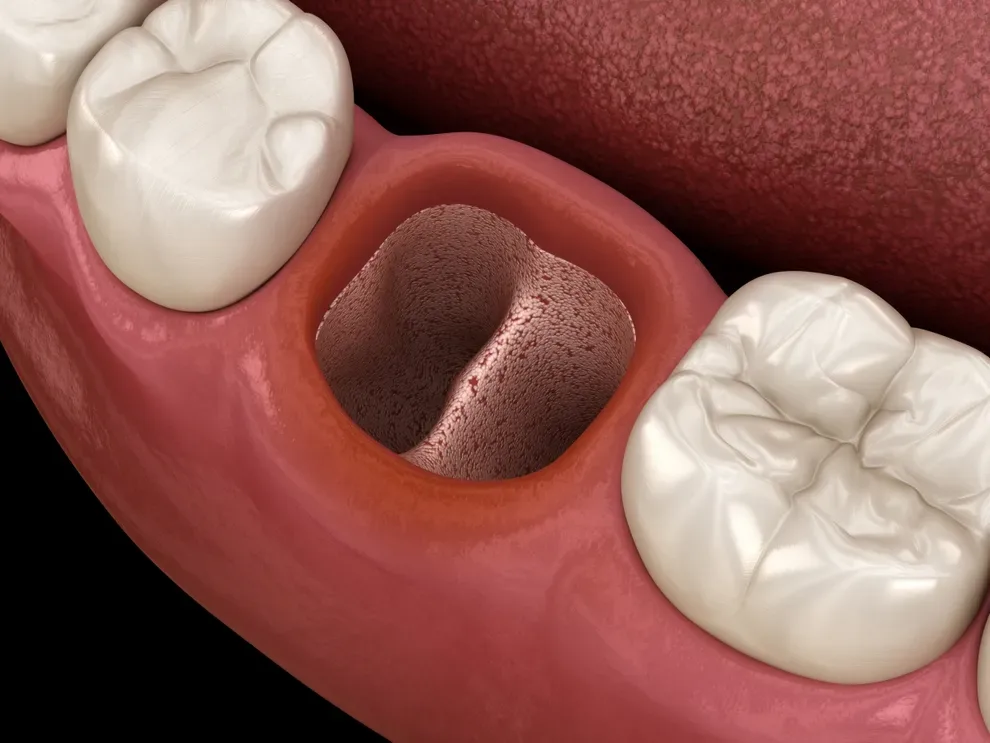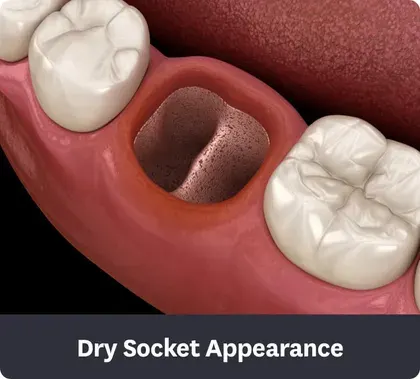What Does a Dry Socket Look Like?

Table of Contents
- What Does Dry Socket Look Like?
- What is the White Stuff?
- Risk Factors & Symptoms
- Treating Dry Socket
- Dry Socket Healing Time
- Is a Dry Socket Dangerous?
- Lowering your Risk
- Dry Socket FAQs
When you have your wisdom teeth removed or you have a tooth removed as an adult, your dentist may warn you about a condition called dry socket. This occurs when infection sets into the root pulp area where a tooth used to be.
In a healthy post-surgery mouth, a blood clot forms on the gums to begin healing tissue in the area, protecting the nerve and bone underneath. If the blood clot fails to form or becomes dislodged, the exposure can be painful and take much longer to heal. It can also become infected.
You can experience serious pain in your mouth for up to five days if you develop dry socket, due to exposed nerves, gums, and even bone.
The medical term for dry socket is alveolar osteitis. It is most common in people who have had their wisdom teeth removed.
What Does Dry Socket Look Like?

Dry socket looks like a substantial hole at the site where the tooth was removed. This hole occurs because the blood clot has been dislodged. The bone may be visible in the hole.
While some people may be able to see this hole, it takes a professional to diagnose the issue. It can be difficult to see well inside your own mouth, even with the use of a mirror.
What is the White Stuff in the Tooth Extractions Site?
If you see white tissue forming around the extraction site, it could be granulation tissue. This tissue may form about a week after a dental procedure like a tooth extraction.
Granulation tissue is part of the healing process and indicates proper recovery. The tissue (which can also appear pink or red) helps to repair and protect the area.
If your granulation tissue appears to have fallen out, it’s a sign that you have a dry socket.
If you see white around the tooth extraction site that doesn’t appear to be tissue, it could be a sign of a problem. The white you see could be the following:
Gauze: If gauze was used in your procedure, it’s possible a bit was left behind. If it doesn’t dislodge with normal care, call your dentist to have it removed. If it remains on the site, it may cause an infection.
Food particles or debris: The wound may attract food particles. Ask your dentist when it’s safe to use a saltwater rinse. If the debris appears stuck, you may need to go into the office to have it safely removed.
Infection: If it appears the white is pus (pus may be yellow as well), seek immediate dental care. You may have an infection or abscess. Other signs of an infection include swelling, pain, fever, and an unpleasant odor in the mouth.It’s vital to treat an infection as quickly as possible to prevent it from spreading to your jaw, neck, or other parts of your body. Your doctor or dentist may prescribe antibiotics and/or pain medication to help with the infection.If you have symptoms of an infection, seek medical care quickly. Complications from an untreated infection can be life-threatening.
How Common Is Dry Socket?
Dry socket occurs about 3% of time with tooth extraction. However, its prevalence jumps up to 30% when a wisdom tooth is pulled.
Since it is a common complication of wisdom tooth extraction, your dentist or oral surgeon will likely make you aware of the risk. If you notice any symptoms, contact them right away.
Risk Factors & Symptoms of Dry Socket
Dry socket is diagnosed by a dentist. It looks like an exposed socket where a tooth used to be, but the blood clot is missing. If you open your mouth, you might be able to see this, but a medical professional will be able to officially diagnose dry socket.
You are at higher risk for developing dry socket if you meet the following criteria:
Smoke and do not stop while your socket heals
Have generally poor oral health
Have a difficult tooth extraction
Take hormones, which can interfere with the healing process
Have had dry socket in the past
Drink from a straw while the socket heals
Vigorously rinse and spit while the socket heals
After you have a tooth extracted, you may have some moderate pain in the area for a few days. Your dentist may prescribe painkillers or recommend a specific dose of over-the-counter painkillers. If pain gets worse or lasts longer than two to three days, you may have developed a dry socket.
Symptoms of dry socket include the following:
Pain that becomes severe within one to three days after a tooth is pulled
Pain that radiates from your ear or eye, temple, neck, or side of your jaw or face where the tooth was pulled
Bad taste in your mouth
Bad breath, halitosis, or an odor coming from your mouth
Slight fever associated with infection
If you develop these symptoms, get in touch with your dentist for a follow-up appointment. Do not ignore these symptoms because your gums and jaw can become infected, which puts your overall health at greater risk.
Pain from dry socket alone can last up to seven days total. If you do not get the right care, you may suffer longer from infected bone or tissue.
Treating Dry Socket
Go to your dentist for treatment. A medical professional can help you manage the symptoms of dry socket and avoid infection. About 45 percent of people who develop dry socket need medical intervention to manage it, so do not delay.
Your dentist will clean out the area, flushing out food particles or other material that has collected in the socket. They will fill the socket with medical paste, and use a dressing to seal it and promote healing. You may need to return to your dentist in a few days or weeks to have the dressing changed.
You may get a prescription for antibiotics, which might be oral pills or a special antibiotic mouthwash. If the pain from dry socket is severe, you may also receive a prescription for pain medication or an irrigation solution. This can help to manage the pain for a few days, until the socket begins to heal.
At home, you can care for your oral health by using all prescriptions according to your dentist’s instructions and closely following their care instructions. If swelling or inflammation causes discomfort, you can gently apply a cold compress to your face, near the affected socket.
Do not put a piece of ice or a cold compress inside your mouth. Avoid smoking and drinking alcohol while you heal.
Dry Socket Healing Time
If treated properly, a dry socket will usually heal within 7 to 10 days. A dry socket is healed when new tissue forms to protect the extraction site.
A dry socket will take longer to heal and may require dental care if any complications occur. Possible complications include infection or stuck food debris in the recovering area.
Is a Dry Socket Dangerous?
While a dry socket isn’t necessarily dangerous, it can be very painful. Complications like infections are relatively rare, and the condition will usually heal rather quickly with proper care.
Dry socket can also slow healing time, meaning the extraction area is exposed and vulnerable for longer. This can result in problems like stuck food particles or bacteria buildup (which can lead to gum problems and tooth decay) in the area.
It can also increase the risk of infection. While infections aren’t common with dry socket, they can be dangerous, especially if not treated quickly. As with any infection in the mouth, there is a risk of spread to the neck, jaw, or other parts of the body.
The risk of complications from dry socket is higher for those who have weakened immune systems. If your immune system is compromised due to illness or a chronic health condition, be sure to take care of the extraction site and bring any issues to your dentist’s attention.
Lowering your Risk of Dry Socket
Many people need to have their wisdom teeth removed. It is a very common dental practice in the United States. Proper care after this common extraction greatly reduces your risk of developing dry socket.
If you need to have more teeth pulled due to injury or infection, you are at risk for getting dry socket every time. Practicing good oral hygiene, including getting regular checkups and cleanings with your dentist, means you are less likely to suffer pain or infection in your mouth.
Dry Socket Frequently Asked Questions
A dry socket is a complication that can develop after the extraction of a wisdom tooth. It usually forms three to five days after the extraction, although it can take a few days longer.
Formation happens when the blood clot that is supposed to develop after an extraction does not develop or else falls off before the wound heals properly. The clot protects the bone and nerves in the gum. When it does not form, dry socket develops.
In cases in which you treat symptoms at home, a dry socket often heals on its own, although it can last as long as 7 to 10 days. Home treatment involves flushing the area with a saline solution and covering it with gauze. You will want to get a plastic syringe to help with the flushing. If your condition is severe, you will need to change the dressing a couple of times.
Pain is often severe, especially during the first 24 to 72 hours. Most people have to see a dentist promptly to address symptoms, get their pain under control, and promote full healing. Over-the-counter painkillers may not be sufficient to control pain, so prescription painkillers may be needed. You may need several visits to your dentist to manage the pain.
Medication is often part of the healing process. Antibiotics are often prescribed to prevent and treat infection, and this promotes pain relief. For mild pain, over-the-counter painkillers can help. However, in many cases, prescription pain medications are needed.
A socket looks like a hole in the place where the tooth was extracted. In most cases, the bone in the socket or the area around it becomes exposed, giving it a different color from the rest of the gum and teeth. Because there is no blood clot formed, the area appears dry, empty and with a seemingly white or bone-like color.
If food and bacteria have gotten into the socket, it can display different colors: yellow, green, or black. It is also possible for some patients not to see a clear dry socket. They will only see a hole.
